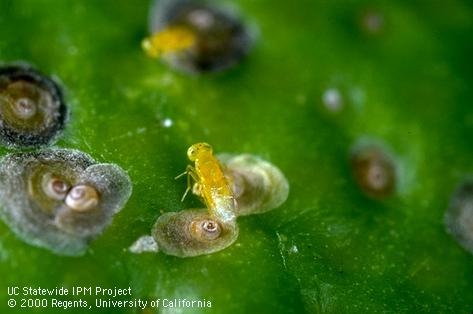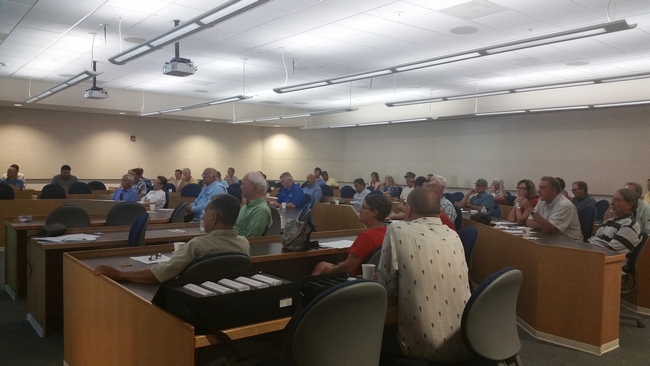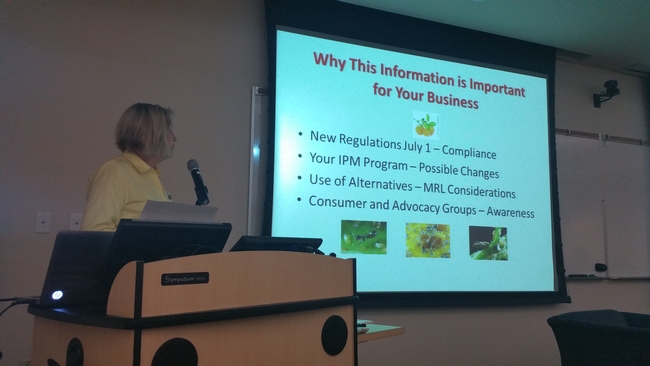
Posts Tagged: wasps
Biocontrol and How to Release It
Biological control is the management of pests and their damage by the beneficial action of parasites (parasitoids), pathogens, and predators. These beneficial organisms, collectively, are named natural enemies.
Conserving (or protecting) and releasing natural enemies are important components of integrated pest management (IPM). In most situations, employing practices that conserve natural enemies is more effective, and less expensive and time consuming, than purchasing and releasing them.
Learn about the specific situations where purchasing and releasing parasites and predators can increase the effectiveness of biological control. Before purchasing natural enemies, consult the University of California (UC) IPM Pest Management Guidelines for that crop to learn whether UC research has shown that releasing them is effective. Some natural enemies on the market have never been demonstrated to effectively control any agricultural pest in California.
Obtaining Natural Enemies
Natural enemies can be purchased directly from various producers (companies that rear them) and suppliers (companies that purchase from producers and repackage and resell them). Some sources of parasites and predators are members of the Association of Natural Biocontrol Producers (ANBP). All ANBP members formally agree to a code of ethics and standardized methods.
Natural enemies purchased by users are commonly delivered via shipping services. Purchase parasites and predators only from in-state providers. It is illegal to obtain insects and other arthropods outside of California and carry or have them shipped across state lines without a permit from agricultural officials. Some pest control advisers and pest scouts will procure and release natural enemies as a service for growers.
Methods for Releasing Natural Enemies
Two methods for releasing natural enemies are inoculation and inundation:
- Inoculation—relatively few natural enemies are released. The offspring of these natural enemies provide biological control, not the individuals released.
- Inundation—large numbers of natural enemies are released, often several times over a growing season. The natural enemies released, and possibly their offspring, provide biological control.
The mealybug destroyer is an example of a natural enemy that is only released through inoculation—at relatively low numbers once per year early in the growing season. Aphytis melinus and Trichogramma parasites are released by inundation—at regular intervals over the growing season—to control California red scale and eggs of pest moths, respectively. Both inoculation and inundation can be used with predatory mites, depending on the situation.
Releasing Natural Enemies Effectively
Releasing natural enemies is most likely to be effective in situations where: 1) University of California researchers or other pest management experts have previously demonstrated success and 2) some level of pests and their damage can be tolerated in that crop. Desperate situations are not good opportunities for releasing natural enemies. Pests or their damage may already be too widespread for any release of parasites or predators to prevent economic loss of crop quality or quantity.
Increase the likelihood that natural enemy releases will be effective by
- Accurately identifying the pest and its natural enemies.
- Learning about the biology of the pest and its natural enemies.
- Releasing the appropriate natural enemy life stage and species.
- Releasing when the pests' vulnerable life stage(s) are present and at numbers that can be controlled by natural enemy releases.
Natural enemies are unlikely to be effective when released as if you were applying a pesticide. Instead, anticipate pest problems and begin making releases before pests are too abundant or economic damage is imminent.
- Remember that natural enemies are living organisms that require food, shelter, and water. Protect them from extreme conditions. For example, release them at night or early in the day during hot weather.
- Avoid applying broad-spectrum, residual (persistent) insecticides and miticides, and in some situations certain systemic or other pesticides, before or after releasing natural enemies. When needed, use pesticides selectively. For example, spot spray only where pests are abundant but localized.
Common reasons for the lack of satisfactory biological control after releases include the
- Application of broad-spectrum, residual insecticides, or in some situations systemic or other pesticides, prior to or after a release.
- Incorrect timing of release.
- Release of the wrong natural enemy for the pest situation.
- Release of a natural enemy species that is known to be ineffective.
For information on the use of biological control, see the UC IPM Pest Management Guidelines for your crop and specific pests. Most crops have a table called “Relative Toxicities of Insecticides and Miticides to Natural Enemies and Honey Bees” in the “General Information” section. Use these resources to guide pesticide selection to conserve natural enemies and improve biological pest control.
More Information
- Association of Natural Biocontrol Producers, Clovis, CA
- Grower Guide: Quality Assurance of Biocontrol Products (pdf), Vineland Research and Innovation Centre, Ontario
- Insectary Plants
- Natural Enemies Gallery
- Natural Enemies Handbook: The Illustrated Guide to Biological Pest Control
- Protecting Natural Enemies and Pollinators
- UC IPM Pest Management Guidelines
this is a repost from:
Photo: Adult Aphytis melinus parasite laying her egg in California red scale, Aonidiella aurantii. Releases are most effective when ants are controlled, dust is minimized, and broad spectrum pesticide applications are avoided. Credit: Jack Kelly Clark, UC IPM Program

Aphytis
Annual Citrus Grower Seminar in Southern California: A Review
The Citrus Research Board in conjunction with the University of California Cooperative Extension (UCCE) held their annual grower seminar on Tuesday, June 30, 2015 at the University of California, Riverside (UCR) Palm Desert Center. Seminars also took place in Santa Paula, CA on June 25th and in Exeter, CA on July 1st. Speakers from all over the state from different agencies shared their knowledge and expertise with the group.
Mark Hoddle, a Biological Control Specialist at UCR gave an update of the biological control of Asian citrus psyllid (ACP). The ACP's natural enemy, Tamarixia radiata has been successful since its release in Southern California in 2011. The Tamarixia kills the ACP nymphs either by parasitizing them (i.e., females eggs laid underneath ACP nymphs and the parasitoid larvae burrow into the nymph to feed which kills the pest) or by host feeding (i.e., female parasitoids stab the nymph with their ovipositor, a tube that they use to lay eggs, and they feed on the body juices that leak from these wounds. This kills the nymph too). Hoddle reminded us, in order for this biocontrol program to continue to be successful, ant populations must be controlled. ACP nymphs produce a white, sugary waste product called honeydew, a good carbohydrate source for the ants, therefore, the ants will protect the nymphs from Tamarixia. His current research showed that when an ant population is reduced, parasitism control increases significantly. Hoddle and his lab will be testing different organic and conventional pesticides for their efficacy against Argentine ants in citrus orchards.
For example, he is in the works of helping produce a more effective ant-bait by working on a biodegradable hydrogel. These hydgrogels are made from algae and crab shells. The material is engineered to encapsulate a 25% sucrose solution with a tiny amount of pesticide and ant pheromone. The liquid bait "leaks" onto the surface of the hydrogel, ants drink it, take it to the nest and slowly intoxicate the queen and nest mates. The baits, about the size of a jellybean, will be engineered to have a certain life time before they "dissolve". He anticipates these jellybean like baits being able to be broadcasted under trees (like you would slug/snail pellets) and the pheromone will attract the ants to them. Once they start to feed, the ants will lay down their own trails to the baits. Mark Hoddle is also the director of the Center for Invasive Species Research, for more information regarding his work on biocontrol, please visit: http://cisr.ucr.edu/.
Victoria Hornbaker, from the California Citrus Pest & Disease Prevention Program Manager and grower Curtis Pate, also the grower liaison from Imperial gave updates on the current ACP management areas (Fig. 1). Curtis, reminded the growers, ACP is attracted to bright colors, such as yellow. Yellow is a common color for most safety vests and jackets, this creates an issue because most people that own one of these pieces of clothing are unaware that they can very well be unknowingly transporting this pest to different locations (Fig. 2). Basic measures such as rolling up vehicle windows, shaking off clothing 
Lori Berger, with the UC Statewide Integrated Pest Management (IPM) Program gave an update on the Chlorpyrifos Critical Use Project (Fig. 3). The project is a multi-year effort to identify the pest management needs and practices for use of Chlorpyrifos in important crops in California. To accomplish this goal, Department of Pesticide regulation (DPR) contracted with UC IPM program to convene industry leaders to work together to create commodity specific guidelines for specific cropping systems. Chlorpyrifos is used on critical citrus pests such as ants, ACP, scales, bud mite, leafminers and many other arthropods. Growers are required to now obtain a restricted materials permit from their local County Agricultural Commission since DPR has designated the insecticide for restricted use in California as of July 1, 2015. The permit conditions may include buffer zones near sensitive sites, good management practices to reduce drift or offsite movement into the air and measures to reduce runoff into surface waters. For Southern California growers, a more in depth meeting will be held at the San Diego Farm Bureau in Escondido on September 15, 2015, more information on this meeting will available in the near future. DPR hours for laws and regulations will be available. More information on the Chlorpyrifos Critical Use Project can be found at: http://www.ipm.ucdavis.edu/IPMPROJECT/CDPR_Chlorpyrifos_critical_use_report.pdf.
Ben Faber, a UCCE Farm advisor from Ventura/Santa Barbra County gave a great presentation on how to interpret soils/water/leaf analyses and managing water in a drought. Soil and water reports are best used for identifying problems in: 1) pH (power of hydrogen); 2) salinity (how much salt is in the soil); 4) chloride (Cl-); 5) sodium (Na+); 6) boron (B); and 7) sodium adsorption ration. Most of the issues listed can be managed by leaching. Unfortunately, there are no definite measurements for fertility management of perennial crops, however, understanding the fundamentals of interpreting analyses is key for a healthy producing grove. For example, when one is handed a report, many may get overwhelmed by the sight of all these things that are reported. Many of those numbers are only on there because they are required to be there by law and may not have an importance to you as grower when it comes to management decisions. You may ask yourself, what is really important in all this? Faber, gave the growers a quick review, for example, in a water analyses we would want to look for look for some basic ranges in: Boron, this element should be no higher than 1 parts per million (ppm), sodium and chloride no higher than 100 ppm, and the TDS (total dissolved solids), this may also be known to some as EC (electrical conductivity), should be no higher than 1,000 ppm. Simple, right?
When dealing with pH, it is always best to balance that out before one plants trees. Trying to balance the pH after a crop has been established can be challenging and you may run the risk of injuring or killing your trees in the process. Those that would like to learn more on soils/water/leaf analyses and managing water in a drought, you can visit Ben Faber's UCCE County website: http://ceventura.ucanr.edu/Com_Ag/Subtropical/.
Neil McRoberts. Professor of Plant Pathology from UC Davis had interactive question and answer session with the audience, gathering grower's views on approaches of control for ACP/ Huanglongbing, also known as citrus greening disease. The answers to this survey will be helpful in creating a management plan to better help growers with their ACP treatment and preventative planning. Michelle Richey, assistant Director of Food Safety from Ott and Davison Consulting also gave a quick update on Food Safety and Good Agricultural Practices certification. She stressed on how important it is to keep records of everything that happens in a business and to have them accessible.
We had a great turn out and hope to see more growers at next year's Southern California meeting.



